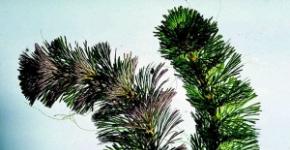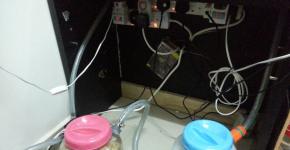Cabomba Caroline. Cabomba Caroline - Cabomba caroliniana.
Water cabomb is very popular among aquarists, not only because of its pleasant appearance, but also because of its unpretentiousness in planting and maintenance. It grows everywhere in the waters of South America, it is like a watery weed, fixed at the bottom with its fleshy roots, painting the waters with its rich colors. About landing and caring for kabomba in the aquarium, we'll talk further.
How to plant kamombu in an aquarium?
Since cabomba is an unpretentious plant, plant it simply and quickly. Usually a bushy plant is simply planted in the ground, for reliability, you can press it with a stone at the rhizome. In this case, no special fertilizers are required, and can vary in the standard range from 23 to 27 degrees. If you want a kabomba in an aquarium to delight you with its pomp and riot of color, separate the top of the plant from the stem of the plant - a new, grown shoot will be more bushy than the previous.
Depending on your own preferences, you can land like a regular green water cabomb or a relative of brown color - both will look interesting among aquarium animals.
Cabomb Aquarium Plant Content
We mentioned the unpretentious cabombs more than once, the plant can easily coexist with the inhabitants of the aquarium, does not require special care or fertilization, but there is one thing that can cause a bushy aquatic plant to die - dirty water. Kabomba loves cleanliness, and therefore does not make friends with the fish digging in the ground. The cabomba also loves light and with pleasure stretches to it, growing up to 2 m in length.
Reproduction cambish
Like most aquatic plants, kabomba propagates vegetatively, which means in order to increase the number of this beauty in an aquarium, it is enough to cut the sprout into pieces and plant it in the ground so that a couple of leaves will appear under the layer of soil. Is done.
Kabomba Karolinska easily propagated by cutting the stem or rhizome. Whole stalks of cabomba, separated from the rhizome or with a piece of it, very soon begin to grow in a new place. By dividing the stems into parts with 5-6 leaf whorls, you can also get new plants, but this process is rather slow.
The lower part of the stem with the roots, as well as the apical stalk, begin to grow somewhat faster than intermediate cuttings, which stop growing before the formation of the root system.
To get rid of the accumulation of suspended particles on the leaves of the plant will help mechanical filter. Keeping the cabomb is necessary in large aquariums with stable biological balance without signs of brown algae. Even ancistrus fish are not always able to clear small leaves from algae.
Treatment of diseased fish should be carried out only in a separate aquarium. Kabomba Karolinska does not tolerate rivanol and copper sulfate drugs. After the use of these drugs kabomby leaves peel off.
To mollusks who like to gnaw tender leaves of plants include coils, fizy, ampouleries. Before planting a kabomb in an aquarium, it is necessary to get rid of such mollusks.
What does a karomba look like?
This perennial plant is distinguished by the following features:
Stem long, thin, upright, weakly flowing. At the surface of the water begins to sweep.
Leaves located on an underwater stem opposite or three leaves in a whorl. They have a finger-cut sheet plate in the shape of a fan with long thin segments. Upper leaves - floating, whole, arranged alternately. All leaves have scapes.
The roots thin, fibrous, underdeveloped, strengthened in the ground.
Flowers solitary, located in the axils of floating leaves.
What conditions should be in the aquarium?
This representative of the family kabombovyh quite undemanding.
Aquarium volume can be absolutely anyone.
Water parameters. A moderately warm aquarium with a temperature of 18-22 ° C or a tropical one with more than 24 ° C will be suitable for the plant. The requirement for stiffness - 8, for acidity - 5.5-6.8. In hard water, the plant becomes shallow and loses leaves.
For cabomba, clean water is important, because in muddy water it attracts particles and becomes outwardly unattractive, and if heavily soiled, the leaves may even die. It is necessary to remove sediment in a timely manner and make water changes three or four times a month.
Lighting should be bright, natural or artificial (with the power of fluorescent or incandescent lamps of 0.5 W per 1 liter of volume), with a light day of at least 12 hours. If there is not enough light, then the plant turns yellow, fades and is strongly drawn out in length.
Priming. It is better to use small pebbles and coarse sand, since creeping rhizomes are poorly formed in the coarse coating of the bottom. In old aquariums, the ground is already naturally silted, and such feeding with kabomba is sufficient. When planting plants in the new reservoir contribute at will, but it is not necessary. Dry red clay balls can also be put under the roots. The homeland is North and South America.
Very long-stem plant, widespread among aquarium lovers. It adapts well to different conditions, grows rapidly, and actively participates in the circulation of substances in the aquarium. Thickets cabombs They are an excellent refuge for fry and are often used as a substrate for spawning many fish. You can grow this plant in an aquarium of any size. It is better to have it in the background, where it forms a magnificent openwork curtain. Cabomba growing evenly throughout the year. 
To the conditions of the plant relatively undemanding. It can be kept in a moderately warm aquarium at a temperature of 18-22 ° C and in a tropical aquarium with a water temperature above 24 ° C. Cabomba prefers water of hardness below 8 °, with a neutral or slightly acid reaction (pH 5.5-6.8). It can be taught to more hard water, but then it grows more slowly, and its leaves become smaller. Kabomba loves clean water. In the cloudy water, it collects parts of dregs and loses its attractiveness. If sediment is not removed in a timely manner, old leaves quickly die. Aquarium water should be changed regularly 3-4 times a month.
DESCRIPTION
Cabomba caroliniana pulcherrima
Cabombaceae family - Cabombaceae.
Distributed in the southeastern regions of North America.
It has very beautiful thinnest fine cutting leaves. The conditions of detention are more demanding than the usual form of Carolina cabomba, so it is less common among aquarium lovers.
The plant can be kept in moderately warm and tropical aquariums at a temperature of from 20 to 28 ° C. Particular attention should be paid to water hardness. This subspecies of cabomba can grow only in very soft water (hardness not exceeding 4 °). With a stiffness of 5 ° and more, the leaves of the plant shrink, growth slows down, the stems gradually die. The active reaction of the water should be slightly acidic or neutral. It is advisable to regularly replace the water 3-4 times a month.
The plant requires bright lighting. With the right light mode, the young leaves of the plant become purple in color, while the old leaves retain the pink color of the underside. With a lack of light, the stem begins to stretch, the leaves turn pale and become light green. For artificial lighting, you should use a combination of fluorescent lamps type LB and incandescent lamps. The power of fluorescent lamps must be at least 0.4 W per 1 liter of volume. Directly above the plant should be placed incandescent lamp with a power of 25-40 watts. Very useful scattered sunlight falling on the aquarium for 1-2 hours per day.
Kabomba the most beautiful develops a fairly strong root system and needs nutrient soil. Natural silting without additional additives is usually enough for a plant. The thickness of the soil layer must be at least 5 cm.
Under optimal conditions, kabomba grows very quickly and easily propagates by cutting. Even from small pieces of the stem, with 3 whorls of leaves, you can get a new plant. Cuttings can either be planted immediately in the ground, or left to float until the root system appears. 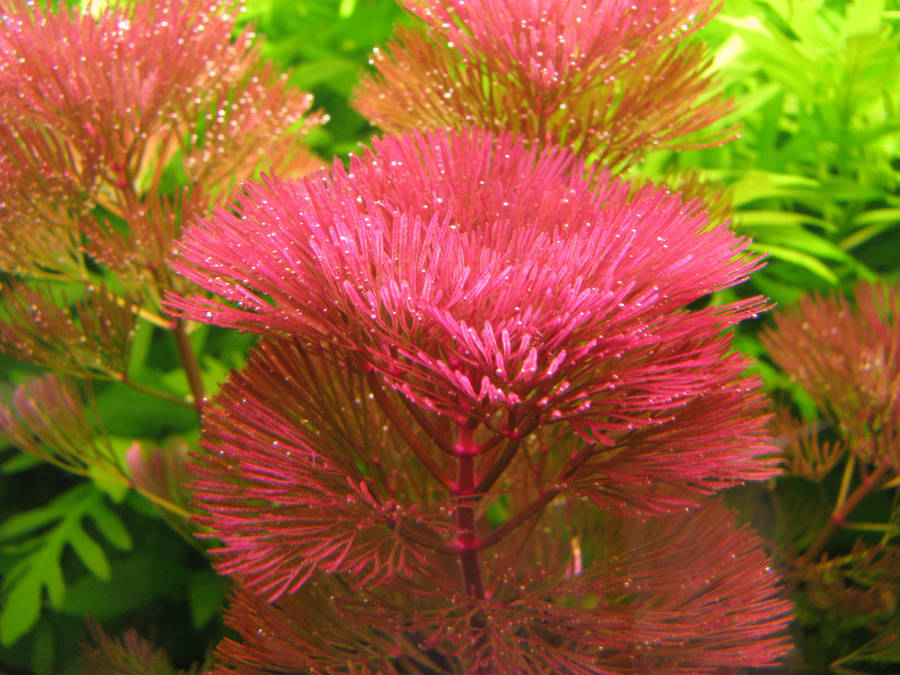
About species
The first type is Carolina cabomba. This kind of demanding lighting and loves clean water. Kabomba Karolinskaya grows very intensively, therefore, periodically it is necessary to cut some of its bushes. If you do not do this, the Karolinian cabomba can grow up to 2 meters. Reproduction occurs by cutting the stem.
Water kabomba (common cabusta, bushy) has several distinctive features from the Caroline variety concerning appearance. So, this bush does not have a branched stalk so strongly that the water cabomb does not look too thick. The remaining features of the water cabomb make it very similar to the Caroline: caring for it involves the presence of abundant light and clean water in the aquarium. This species, with no cutting, also grows to 2 meters, as does the Caroline variety. In the wild nature, bushy kabomba is found in rivers and in various flowing waters.
Kabomba furkata (it is also called reddish or kabomboy red) is, perhaps, the most original form. The stems of such cabombs are characterized by a red-ruby color. However, the shades may be different. Due to this color kabomba furkata fits perfectly into aquariums, which contain exotic fish. It is not surprising, therefore, that with the help of a red cabomb aquarists decorate their underwater worlds. It is necessary, however, to take into account that the content of a red cabomb in an aquarium is associated with certain efforts: this view, unlike the others, is not only demanding of clean water, but also of temperature (it should be at 25 degrees) and the degree of soil saturation .
Cabomba Caroline - Cabomba caroliniana
Homeland - North and South America.
Very long-stem plant, widespread among aquarium lovers. It adapts well to different conditions, grows rapidly, and actively participates in the circulation of substances in the aquarium. Cabomas are an excellent haven for fry and are often used as a spawning ground for many fish. You can grow this plant in an aquarium of any size. It is better to have it in the background, where it forms a magnificent openwork curtain. Kabomba grows evenly throughout the year.
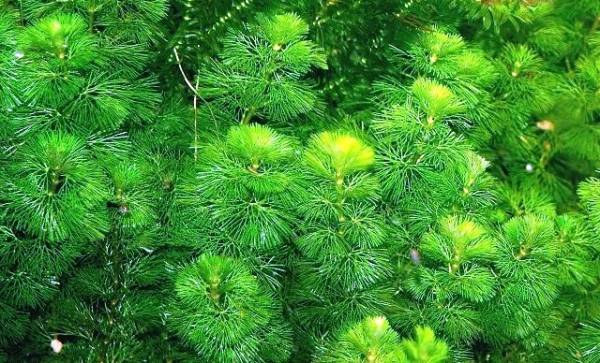
The conditions of the plant is relatively undemanding. It can be kept in a moderately warm aquarium at a temperature of 18 - 22 ° C and in a tropical aquarium with a water temperature above 24 C. The cabomb prefers water with a hardness below 8 °, with a neutral or slightly acid reaction (pH 5.5 - 6.8). It can be taught to more hard water, but then it grows more slowly, and its leaves become smaller. Kabomba loves clean water. In the cloudy water, it collects parts of dregs and loses its attractiveness. If sediment is not removed in a timely manner, old leaves quickly die. Water in the aquarium should be changed regularly 3-4 times a month.

Lighting should be strong enough. With a lack of light, the kabomba begins to be drawn out, its color becomes faded, acquires a yellowish tint. Natural and artificial light is suitable for lighting aquarium where kabomb grows. The approximate power of fluorescent lamps should be 0.4-0.5 W per 1 liter of volume. The duration of daylight hours is at least 12 hours.

The soil should be quite nutritious. In the old aquarium, the plant is enough to feed the natural silting of the soil. When planting in the new soil additional additives are not required. The root system of the kabomba is gentle, but sufficiently developed, therefore, it is better to use sand and small pebbles as a substrate. In the soil consisting of large particles, a creeping rhizome develops worse, which is formed in an old plant.
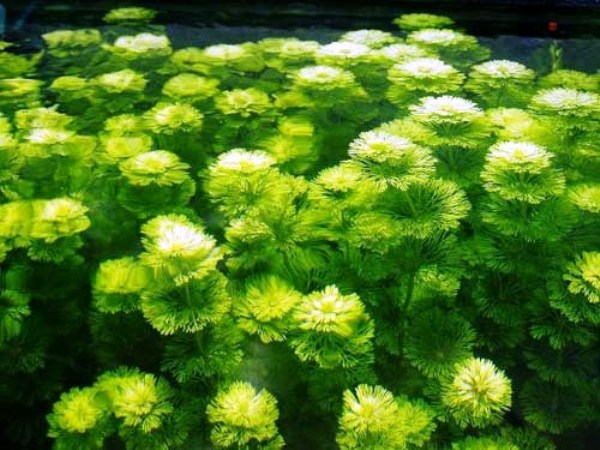
Mineral dressing specifically for cabomba can not make, because it is enough of the nutrients coming from food for fish and fresh water.
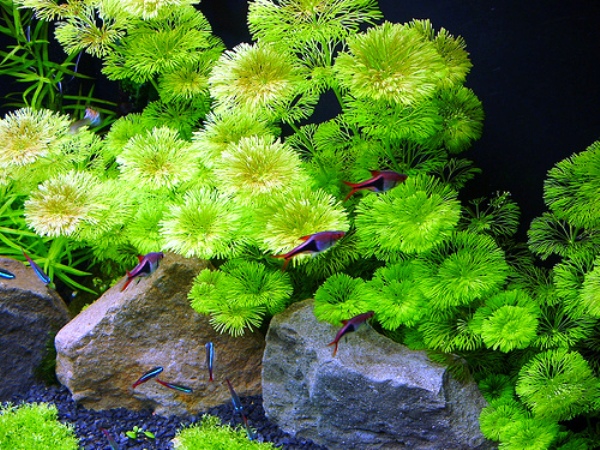
In a kabomba aquarium, it is very easy to propagate by cutting the stem or rhizome. Whole stalks of cabomba, separated from the rhizome or with a piece of it, very soon begin to grow in a new place. By dividing the stems into parts with 5-6 whorls of leaves, you can also get new plants, but this process is rather slow. The lower part of the stem with the roots, as well as the apical stalk, begin to grow somewhat faster than intermediate cuttings, which stop growing before the formation of the root system.
Cabomba the most beautiful - Cabomba caroliniana pulcherrima
Cabombaceae family - Cabombaceae.
Distributed in the southeastern regions of North America.
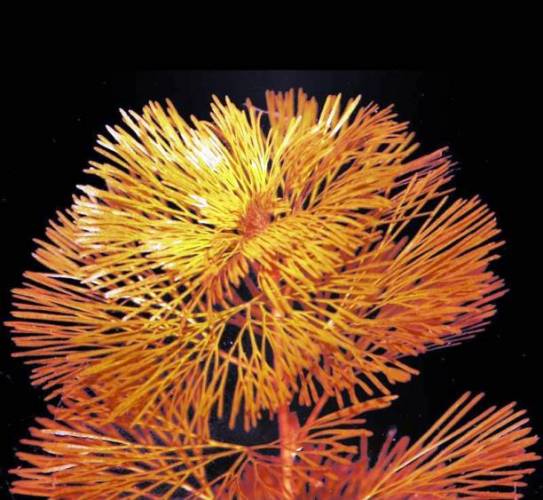
It has very beautiful thinnest fine cutting leaves. The conditions of detention are more demanding than the usual form of Carolina cabomba, so it is less common among aquarium lovers.
The plant can be kept in moderately warm and tropical aquariums at a temperature of from 20 to 28 ° C. Particular attention should be paid to water hardness. This subspecies of cabomba can grow only in very soft water (hardness not exceeding 4 °). With a stiffness of 5 ° and more, the leaves of the plant shrink, growth slows down, the stems gradually die. The active reaction of the water should be slightly acidic or neutral. It is advisable to regularly replace the water 3-4 times a month.

The plant requires bright lighting. With the right light mode, the young leaves of the plant become purple in color, while the old leaves retain the pink color of the underside. With a lack of light, the stem begins to stretch, the leaves turn pale and become light green. For artificial lighting, you should use a combination of fluorescent lamps type LB and incandescent lamps. The power of fluorescent lamps must be at least 0.4 W per 1 liter of volume. Directly above the plant should be placed incandescent lamp with a power of 25-40 watts. Very useful scattered sunlight falling on the aquarium for 1-2 hours per day.

Kabomba the most beautiful develops a fairly strong root system and needs nutrient soil. Natural silting without additional additives is usually enough for a plant. The thickness of the soil layer must be at least 5 cm.
Under optimal conditions, kabomba grows very quickly and easily propagates by cutting. Even from small pieces of the stem, with 3 whorls of leaves, you can get a new plant. Cuttings can either be planted immediately in the ground, or left to float until the root system appears.
Cabomba caroliniana tortifolia
Cabombaceae family - Cabombaceae.
Garden, artificially derived form kabomba Karolinskaya.
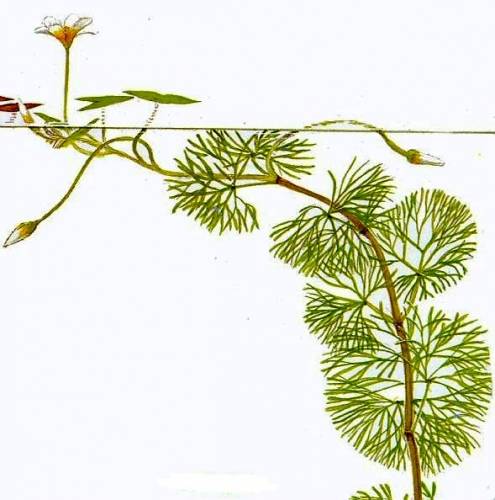
The plant possesses very beautiful thin needle-like leaves twisted into a spiral with a silver shine. The plant is extremely beautiful, but it is much less common among aquarium lovers than the usual form, because of its high demands on the conditions of detention and slower growth.
The spiral-leaved cabomb requires a slightly higher water temperature than the Caroline cabomb. At temperatures below 20 ° C, its growth slows down. It grows only in soft subacid water. The rigidity is greater than 6 ° the plant practically does not tolerate.
The lighting should be brighter than with the content of the usual form of Carolina cabomba.
During the reproduction of a plant, it is necessary to take into account its capricious nature and not to try to divide the stems into small parts. It is best to use whole shoots with roots or part of the rhizome.
In this article I would like to talk about the Carolina cabomba, which is quite widespread in aquariums. It gained its popularity due to its ability to adapt well to conditions, rapid and uniform year-round growth, and active participation in the circulation of substances in the aquarium. About where it came from, how it is used in an aquarium and how to care for this plant and will be discussed.
The homeland of Cabomba caroliniana is North and South America. Its lush thickets can be found in various reservoirs: standing and flowing, slowly and rapidly, but with a bottom no deeper than one and a half meters.
Cabomba in the aquarium
 For cultivation suitable aquarium of any size. The most advantageous kabomba will look in the middle, in the corners and in the background. Moreover, the lush thickets, the more interesting they look, filling the aquarium with bright, rich openwork greens. Lovely duet work with the Canadian.
For cultivation suitable aquarium of any size. The most advantageous kabomba will look in the middle, in the corners and in the background. Moreover, the lush thickets, the more interesting they look, filling the aquarium with bright, rich openwork greens. Lovely duet work with the Canadian.
Not only beauty is important, but also the other roles of cabombo:
- is a refuge for fry;
- serves as a substrate for spawning;
- takes part in the circulation of substances in the aquarium: absorbs harmful substances from the water, purifies the water, attracting suspended particles to itself.
The only problem may be the maintenance of large fish in aquariums with Cabomba caroliniana, as they provoke the fall of the leaves with their movements.
If you prefer chic undergrowth, it is better to stop the choice on small fish, for example, etc.
What does a karomba look like?
This perennial plant is distinguished by the following features:
Stem long, thin, upright, weakly flowing. At the surface of the water begins to sweep.
Leaves located on an underwater stem opposite or three leaves in a whorl. They have a finger-cut sheet plate in the shape of a fan with long thin segments. Upper leaves - floating, whole, arranged alternately. All leaves have scapes.
The roots thin, fibrous, underdeveloped, strengthened in the ground.
Flowers solitary, located in the axils of floating leaves.
What conditions should be in the aquarium?
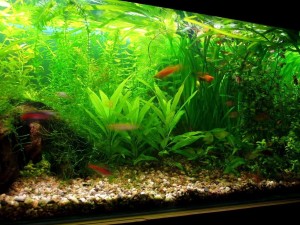 This representative of the family kabombovyh quite undemanding.
This representative of the family kabombovyh quite undemanding.
Aquarium volume can be absolutely anyone.
Water parameters. A moderately warm aquarium with a temperature of 18-22 ° C or a tropical one with more than 24 ° C will be suitable for the plant. The requirement for stiffness - 8, for acidity - 5.5-6.8. In hard water, the plant becomes shallow and loses leaves.
For cabomba, clean water is important, because in muddy water it attracts particles and becomes outwardly unattractive, and if heavily soiled, the leaves may even die. It is necessary to remove sediment in a timely manner and make water changes three or four times a month.
Lighting should be bright, natural or artificial (with the power of fluorescent or incandescent lamps of 0.5 W per 1 liter of volume), with a light day of at least 12 hours. If there is not enough light, then the plant turns yellow, fades and is strongly drawn out in length.
Priming. It is better to use small pebbles and coarse sand, since creeping rhizomes are poorly formed in the coarse coating of the bottom. In old aquariums, the ground is already naturally silted, and such feeding with kabomba is sufficient. When planting plants in the new reservoir contribute at will, but it is not necessary. Dry red clay balls can also be put under the roots.
Cabomba breeding
There are two ways:
Rhizome division
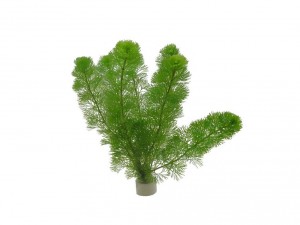 It is important here not to destroy the mother plant, so no more than 30 percent of the creeping rhizomes should be cut off.
It is important here not to destroy the mother plant, so no more than 30 percent of the creeping rhizomes should be cut off.
A sharp knife separates pieces of 2-3 cm. Each piece should have 1-2 buds. They can be left on the surface of the water until the formation of leaves, and then rooted.
Sometimes from the main root grows a new bush. It can be separated, carefully breaking the rhizome, and landed separately.
Stalk cutting
The process is much slower than in the first case. The stem is divided into segments so that each contains 5-6 whorls of leaves.
Parts of the stem are planted in the ground, deepening the lower mutator. About a week later, young roots form.
The upper and lower segments will develop faster than intermediate ones, which do not begin to grow until they have roots.
If the bush has got accustomed, gives new shoots and branches, then it is better not to replant it once again, because the plant does not like it. To begin branching a bush you need to pinch its top.
Important points
- in an aquarium where it is planned to plant a kabomb, there should be a stable biological balance without signs of brown algae, since it is very problematic to clean small leaves from them;
- so that suspended particles do not accumulate on the leaves of Cabomba caroliniana, you will need to install a mechanical filter and do not forget to clean it regularly;
- some mollusks, such as coil, ampulyaria, fiz, like to nibble the delicate leaves of the plant, therefore it is not recommended to keep them together with kabomba;
- if fish are sick in an aquarium and they need treatment, then it should be done in a separate container, since the kabomba does not tolerate drugs (copper sulfate and rivanol) and reacts to them by dropping leaves.
As we can see, caring kabomboy Karolinsky is not so difficult. It is worth making a little effort, and it will delight you all year round with its beauty and benefit your aquarium. Good luck!
Useful video: Karolinsky cabomba - rules of care and reproduction:
Kabomba is a wonderful and wonderful plant, capable. For quite a long time, it continues to remain popular in the aquarium culture and, along with vallisneria, is the most popular among enthusiasts of this hobby, being used for planting in home aquariums.
It originally originates from South America, where it grows in water bodies almost everywhere from Mexico to Brazil. A distinctive feature of cabombs - undemanding and unpretentiousness, which makes it appropriate for breeding, even a novice aquarist. In addition, this plant is really beautiful in its own way and externally is a bushy bush with fleshy stems. Kabomba in the aquarium looks organic and good.
What is the best way to plant and care for the plant?
It is best to place cabomba bushes along the walls to create a beautiful background. They are planted in the ground, although in some cases it is recommended to press the stem with a stone. At the same time, being planted in soft soil, cabomb sprawls to the sides. Nutrients Kabomba gets mainly from water, so additional additives in the soil is not required. The plant needs a temperature ranging from 23 to 27 degrees Celsius, however, it can endure for some time and lowered to 18. From this it is easy to conclude that, as an aquarium plant, cabomba is a good choice and does not need any maintenance requiring special care. knowledge.
In order to achieve splendor from a single bush, you can pinch off a piece of the top. In the spring, the kabomba can bloom, with beautiful yellow flowers rising a few centimeters above the surface of the water. Kabomba in the aquarium brings obvious benefits for its inhabitants. Clusters of cabombs can be used as a shelter for fry and small fish, and can also serve as a substrate for spawning. Today, kabombu can be purchased at almost every specialty store.
However, cabomba, like other plants, is divided into several species, each of which has its own distinctive features.
Varieties of this plant family


